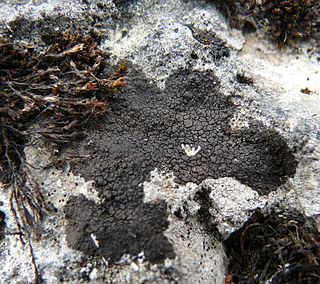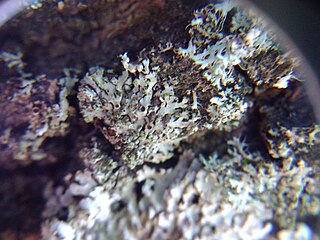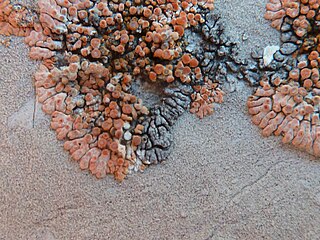
Verrucariaceae is a family of lichens and a few non-lichenised fungi in the order Verrucariales. The lichens have a wide variety of thallus forms, from crustose (crust-like) to foliose (bushy) and squamulose (scaly). Most of them grow on land, some in freshwater and a few in the sea. Many are free-living but there are some species that are parasites on other lichens, while one marine species always lives together with a leafy green alga.

Lichenochora is a genus of fungi in the family Phyllachoraceae. It has 44 species. All species in the genus are lichenicolous, meaning they grow parasitically on lichens. The genus was circumscribed by Josef Hafellner in 1989, with Lichenochora thallina assigned as the type species.
Merismatium is a genus of lichenicolous (lichen-dwelling) fungi of uncertain familial placement in the order Verrucariales. The genus was circumscribed in 1898 by Friedrich Wilhelm Zopf.
Polyblastia is a genus of lichenized fungi in the family Verrucariaceae. As of 2020, it consists of about 40 species combined with about 50 orphaned species. The main difference with the genus Verrucaria is related to spores, which are muriform in Polyblastia.
Sarcopyrenia is a genus of lichenicolous (lichen-dwelling) fungi. It has 11 species. It is the only genus in Sarcopyreniaceae, a family in the order Verrucariales. Sarcopyrenia was circumscribed by Finnish lichenologist William Nylander in 1858, with Sarcopyrenia gibba assigned as the type species. Sarcopyreniaceae is one of the few families composed entirely of lichenicolous fungi.

Abrothallus is a genus of lichenicolous fungi. It is the only genus in the monotypic family Abrothallaceae, which itself is the sole taxon in the order Abrothallales.
Zwackhiomyces is a genus of lichenicolous fungi in the family Xanthopyreniaceae. The genus was circumscribed by Martin Grube and Josef Hafellner in 1990, with Zwackhiomyces coepulonus assigned as the type species.
Dennisiella is a genus of fungi in the family Coccodiniaceae. It has 9 species. The genus was circumscribed by mycologists Augusto Chaves Batista and Raffaele Ciferri in 1962, with Dennisiella babingtonii designated as the type species. The generic name honours British mycologist R. W. G. Dennis. Fungi in this genus are epifoliar; that is, they live on living plant surfaces, particularly leaves.

Phacopsis is a genus of lichenicolous (lichen-dwelling) fungi. They are parasites of members of the large lichen family Parmeliaceae, of which they are also a member. Originally proposed by Edmond Tulasne in 1852 to contain 3 species, Phacopsis now contains 10 species, although historically, 33 taxa have been described in the genus. Many of the species are poorly known, some of them having been documented only from the type specimen.

Hydropunctaria is a genus of saxicolous (rock-dwelling), crustose lichens in the family Verrucariaceae. The genus includes both aquatic and amphibious species, with members that colonise either marine or freshwater habitats. The type species, Hydropunctaria maura, was formerly classified in the large genus Verrucaria. It is a widely distributed species common to littoral zones. Including the type species, five Hydropunctaria lichens are considered marine species: H. adriatica, H. amphibia, H. aractina, H. orae, and H. oceanica.
Calycidium is a genus of lichen-forming fungi in the family Sphaerophoraceae. It has two species. It is one of the few lichen genera containing foliose (leafy) species that produce a mazaedium – a powdery mass of spores. Both species occur in Australasia and South America, where they grow on tree bark or on mosses.

Schaereria is a genus of lichen-forming fungi. It is the sole genus in the family Schaereriaceae, which itself is the only family in the Schaereriales, an order in the subclass Ostropomycetidae of the class Lecanoromycetes. Most Schaereria species are crustose lichens that live on rocks. Schaereria was first proposed by Gustav Wilhelm Körber in 1855 and was later taken up by other lichenologists despite periods of disuse.
Apatoplaca is a fungal genus in the family Teloschistaceae. It is monotypic, containing a single species, the rare crustose lichen Apatoplaca oblongula, found in the United States.
Heteroplacidium zamenhofianum is a species of lichenicolous (lichen-eating) lichen in the family Verrucariaceae. As a juvenile, it is parasitic on some members of the lichen genus Staurothele, but later becomes independent and develops a brown, crustose thallus. Characteristic features of the lichen include its dark brown, somewhat squamulous thallus and relatively small ascospores. It is widely distributed in Europe and North America.
Endococcus hafellneri is a species of lichenicolous (lichen-eating) fungus in the family Verrucariaceae. It is found in North Asia and the Russian Far East, Estonia, and Japan, where it grows on the lobes of the lichens Flavocetraria cucullata and Cetraria islandica.

Verrucula is a genus of lichenicolous (lichen-dwelling) lichens in the family Verrucariaceae. Species in the genus are parasitic on saxicolous (rock-dwelling), crustose lichens, including Xanthoria elegans as well as lichens from genus Caloplaca that contain chemical substances called anthraquinones.
Pyrenidium is a genus of lichenicolous (lichen-dwelling) fungi. It is the only genus in the family Pyrenidiaceae. It has 13 species.
Dimidiographa is a genus of lichen-forming fungi in the family Roccellographaceae. It has three species of crustose lichens, with Dimidiographa loandensis serving as the type species.

Verrucaria viridula is a common and widely distributed species of saxicolous (rock-dwelling), crustose lichen in the family Verrucariaceae. Although it is a somewhat morphologically variable species, two persistent distinguishing characteristics are its relatively large perithecia, which are often curved into a beak, and its large ascospores.
Protothelenella is a genus of fungi in the family Protothelenellaceae. It contains 11 species, some of which form lichens. Protothelenella species have a crustose thallus with spherical to pear-shaped, dark brown to blackish perithecia. Microscopic characteristics of the genus include bitunicate asci with an amyloid tholus, and ascospores that are colourless and contain multiple internal partitions. Some species grow on acidic substrates including rocks, soil, bryophytes, plant detritus or rotten wood. Other species are lichenicolous (lichen-dwelling), growing on species of Solorina, Peltigera, Pseudocyphellaria, or Cladonia.







